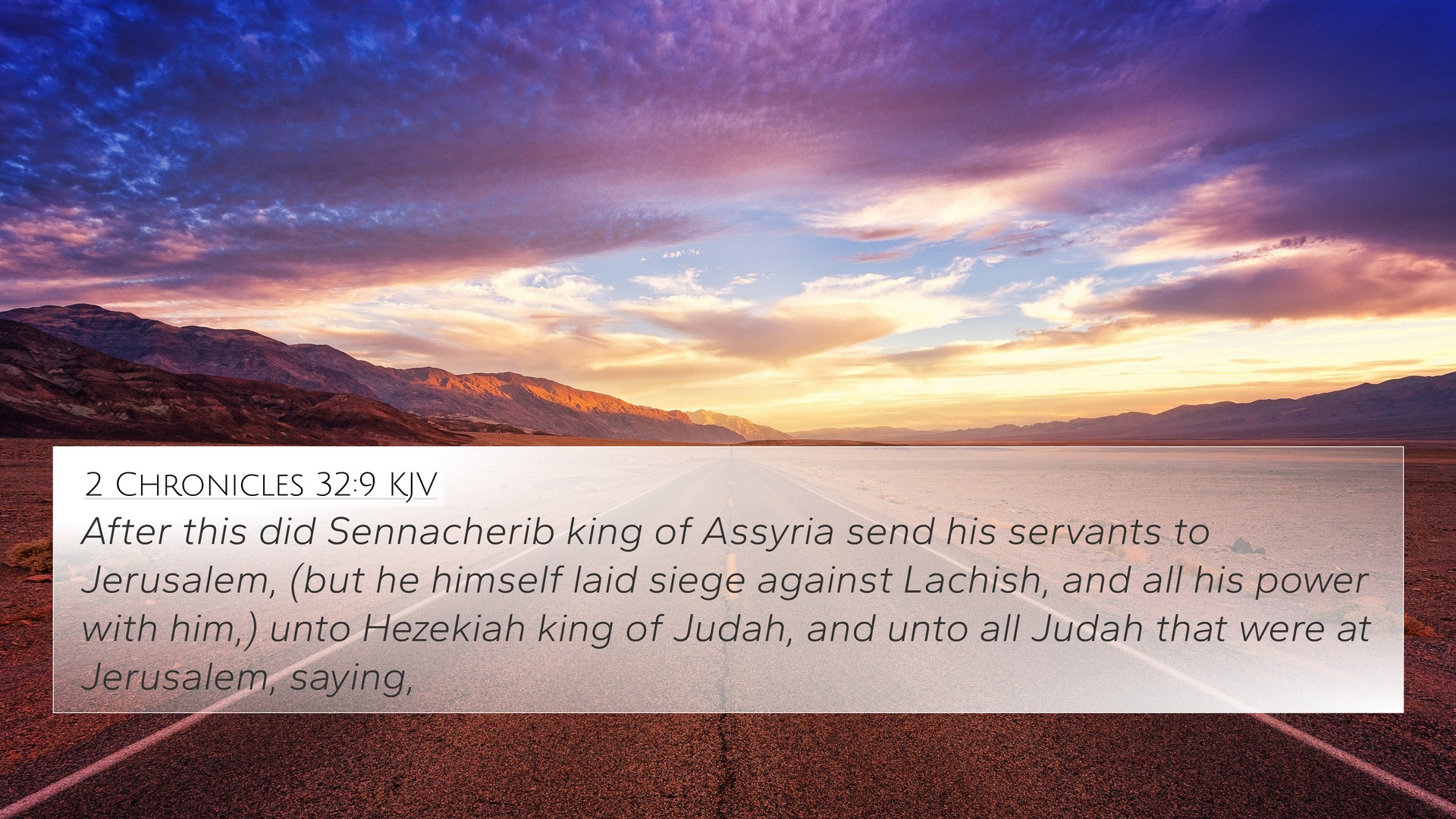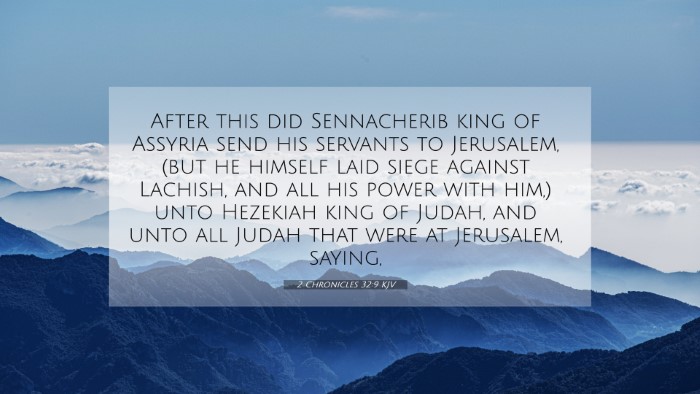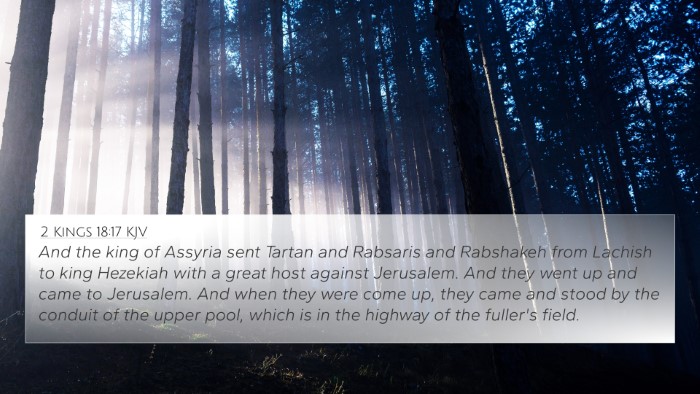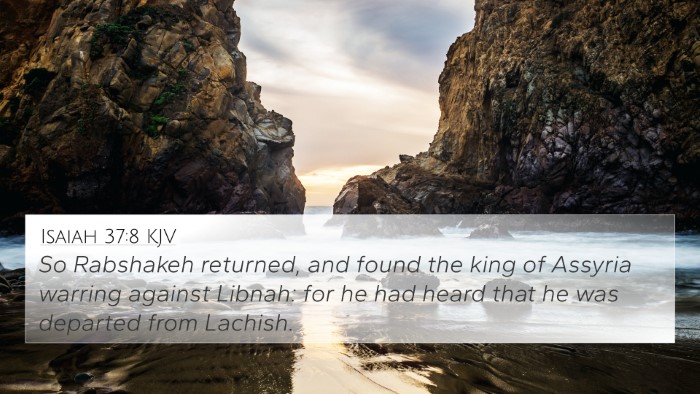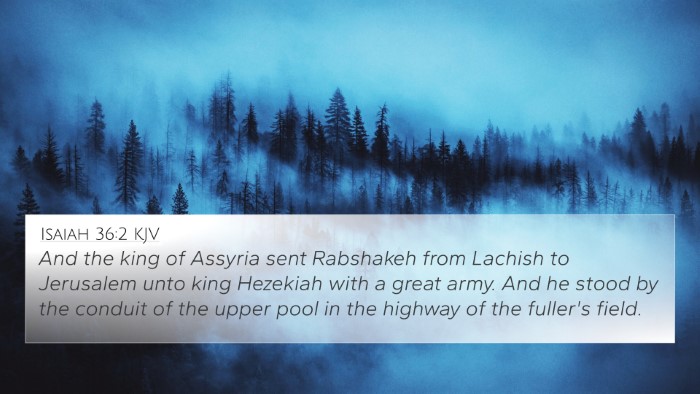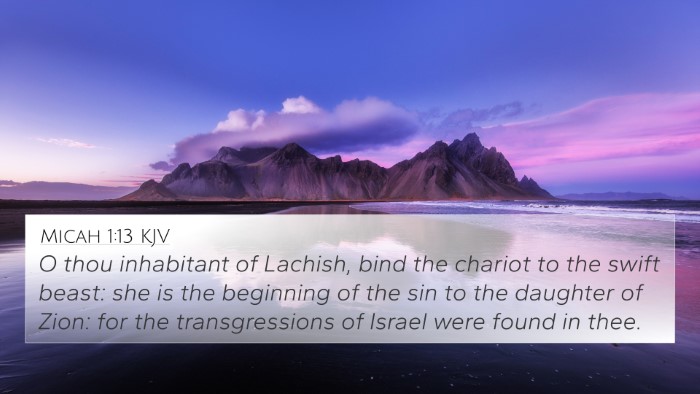Understanding 2 Chronicles 32:9
Verse Reference: 2 Chronicles 32:9
Verse Text: "After this, Sennacherib king of Assyria sent his servants to Jerusalem, but he himself laid siege against Lachish and all his power with him." (2 Chronicles 32:9)
Contextual Background
This verse takes part during a critical period in Judah’s history, under the reign of King Hezekiah. The Assyrian empire, led by King Sennacherib, has invaded the region with the intent to conquer Jerusalem. The threats posed by Sennacherib not only reveal the geopolitical struggles of the era but also serve as a backdrop for understanding the faith and resistance portrayed by Hezekiah and the Jewish people.
Commentary Insights
Matthew Henry's Commentary
Matthew Henry points out that the Assyrian king, Sennacherib, is noted for his pride and blasphemy against God. He highlights the strategic significance of Lachish, implying that its siege was a precursor to an assault on Jerusalem itself. Henry emphasizes that the actions of Sennacherib were a fulfillment of God’s sovereignty — a divine warning to His people about the consequences of turning away from Him. This verse demonstrates the human attempts at warfare alongside divine providence, suggesting readers reflect on the power of faith during trials.
Albert Barnes' Notes
Albert Barnes elaborates on the message of this verse in light of prophetic fulfillments and historical contexts. He discusses how Sennacherib’s focus on Jerusalem while laying siege to Lachish symbolizes the overwhelming threats to faith communities at that time. Barnes encourages understanding the tumult of such times and finding hope in God’s deliverance. He delves into the need for prayer and reliance on divine strength as they faced monumental opposition, a theme echoed throughout scripture.
Adam Clarke's Commentary
Adam Clarke provides insights into the psychological tactics used in warfare and the impact of fear on the besieged cities. He notes how Sennacherib aims to destabilize Judah by eliminating its allies, thereby creating a sense of hopelessness among them. Clarke interprets the verse as a demonstration of the real spiritual warfare that believers face, calling for a steadfast spirit grounded in the knowledge of God's promises amid turbulent times.
Thematic Connections and Cross-References
This verse is rich with connections to other scripture, enhancing its understanding and providing a fuller biblical narrative. Below are cross-references that resonate with themes of faith, resistance, and divine intervention:
- Isaiah 36:1-2: The account details the same invasion from a different perspective, shedding light on Sennacherib's rhetoric and Judah's response.
- 2 Kings 18:17: This parallel verse offers additional historical context about the siege of Jerusalem and the Assyrian strategies.
- Psalms 46:1-3: This passage highlights God as a refuge and strength in times of trouble, an encouraging theme as Judah faces Sennacherib's threat.
- Isaiah 37:6-7: God’s response to Hezekiah’s plea, promising protection from the Assyrians, underscores His sovereignty.
- 2 Chronicles 32:20-21: These verses continue the narrative of deliverance, emphasizing God's intervention in response to Hezekiah's prayers.
- Jeremiah 42:11: A reminder of trusting in God, echoing sentiments in the face of external threats.
- Deuteronomy 20:1: Encouragement for Israel in battles, calling for remembrance of divine assistance.
Faith Under Siege
The conflict represented in 2 Chronicles 32:9 invites believers to reflect on their own struggles. It is crucial to remember that just as Judah faced formidable enemies, modern readers encounter trials that test their faith. The history offers numerous tools for Bible cross-referencing, showing how related verses may provide insight and encouragement. Believers today can learn how to use cross-references to find support from God’s word when facing personal battles.
Conclusion: The Importance of Contextual Understanding
When engaging with 2 Chronicles 32:9 and its surrounding narrative, we gain insight into the interconnectedness of the biblical text. Cross-referencing Biblical texts allows for a richer understanding of scripture. By exploring themes of divine intervention, faith resilience, and the historical context of Hezekiah’s reign, readers can draw significant parallels to their spiritual journeys. The use of comprehensive Bible reference resources and Bible cross-reference guides enrich the study, yielding profound realizations about the nature of God and His unwavering support for His people.
